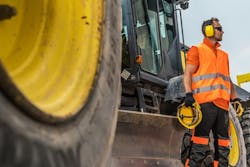Combating hearing loss on construction job sites
It’s estimated that every day, four million workers in the U.S. endure damaging noise levels while at work.
A decade-long study incorporating hearing tests of more than 1.4 million American workers found that construction accounted for the second-highest prevalence of workers with impaired hearing. Sixteen percent of construction workers tested positive for some form of hearing impairment, with 3 percent classed as “moderate or worse” impairment.
Corey Heniser, a vehicle safety expert at Brigade Electronics, has some ideas on how the construction industry can help limit noise pollution on worksites.
Construction noise is inevitable
“Noise is inevitable in the construction industry; anyone working in this sector knows that ‘a quiet life’ is never going to be part of their job description,” Heniser says. “The danger, however, is that long-term exposure to high noise levels can cause Noise-Induced Hearing Loss (NIHL), usually resulting from extended exposure to sound levels at or above 85 dBA. Symptoms include deafness and tinnitus, a distressing ringing in the ears that can have a highly detrimental impact on quality of life.”
The World Health Organization reports that worldwide, NIHL is the most prevalent irreversible occupational hazard.
“Once the damage is done, it’s often too late to be remedied,” Heniser says. “To compound the issue, workers with compromised hearing are themselves at further risk of danger since they may have trouble hearing warning alarms or safety instructions while on site. Fortunately, there are many ways that noise levels can be reduced on construction sites.”
Combating noise in construction
He cites smarter design methods where ducts can be incorporated into a wall at manufacturing stage rather than being chased out on-site, as well as power tools that are being adapted and developed to be ever quieter. “Some noises, such as the tonal ‘beep beep’ of vehicle reversing alarms can be eliminated entirely using the latest backup alarms on the market,” Heniser says.
Commercial vehicle safety systems, including reversing alarms, have long been a solution to alerting those on the ground to danger when a heavy vehicle is moving.
“But research has shown that old-fashioned tonal alarms may be causing significant noise pollution on construction sites, and to people living and working nearby,” Heniser says. “In addition, it’s not always possible to locate the direction from which the alarm originates, meaning its effectiveness can be severely compromised, especially if several alarms are sounding at once.
Multifrequency back-up alarms
Multifrequency alarms are helping to address this problem, according to Heniser. “Rather than the traditional ‘beep beep’ of tonal alarms, they create a ‘ssh-ssh’ sound that is gentle on the ear and dissipates quickly. The alarm can therefore be instantly located and heard only in the danger zone.”
In adverse conditions, Heniser adds, such as when rain is pounding down, the warning decibel level will be increased, but only to the minimum level required to ensure the alarm is heard.
“Although products such as Brigade’s bbs-tek White Sound reversing alarm are a step towards limiting noise pollution, they form only part of the picture,” Heniser says. “Regular monitoring of employees’ hearing alongside reviews of worksite practices and strict adherence to noise guidelines are essential to protect workers from the cumulative effects of worksite noise.”
The Center for Disease Control and Prevention (CDC) estimates that workers in U.S. construction lost 3.09 healthy years per 1,000 workers due to their job. Consequently, the CDC emphasizes the importance of regular hearing tests for workers to enable early intervention if a problem is detected.
